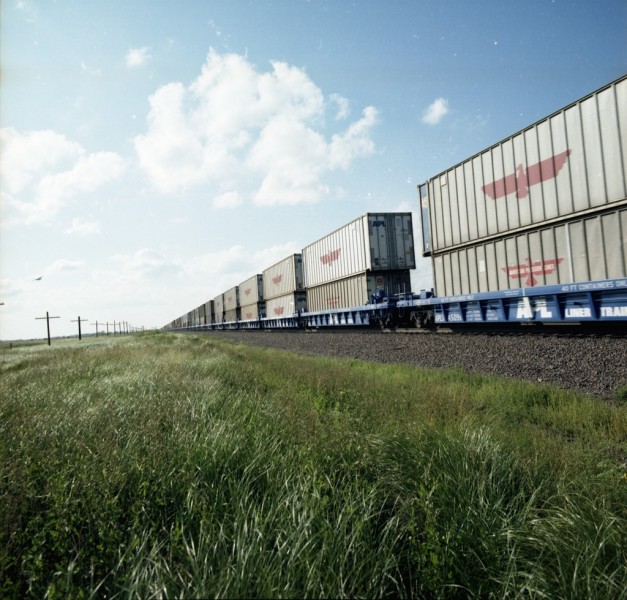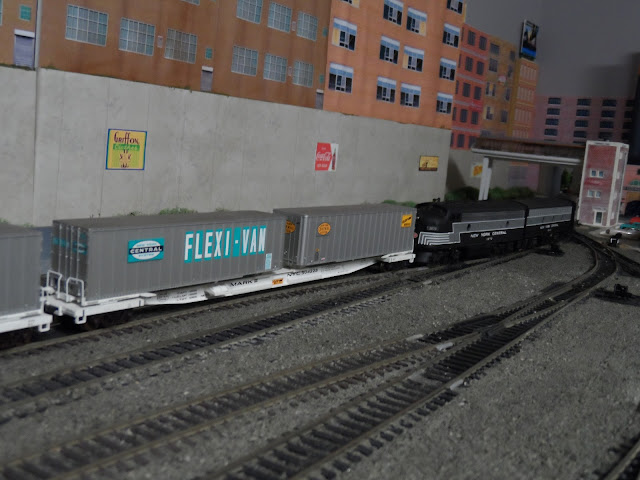Good news to report! The P.C.C.M. gang are going to run an Intermodal Virtual Op starting on Saturday November 17th. This newest virtual op was inspired by John B when he posted an aha moment relative to his double stack container trains.
Before Intermodal became an industry buzzword this type of traffic was commonly referred to Trailer on Flatcar (T.O.F.C.), Container of Flatcar (C.O.F.C.) and the ever popular Piggyback.
Let's explore some of the intermodal traffic that the N.Y.C.T.L. is capable of running.
B&O TOFCEE SERVICE was a marketing play on T.O.F.C. launched in 1954 using 41' and 53' flats. In the early stages of T.O.F.C. the trailers were shorter and so were the flatcars in use.
As trailers got longer single trailers were mounted on flatcars instead of the two shorter ones. This piggyback setup is common for the P.C.C.M. T.O.F.C. traffic between my layout and Ralph's K.P.D. layout. Remember when using a piggyback ramp all trailers need to face the ramp for loading and unloading.
In 1958 New York Central launched its Flexi-Van system and the containers began appearing on certain fast freights and in dedicated service between New York and Chicago in 1960.
By 1965 Flexi-Vans generated 15 percent of Central's profits using only .05 percent of its equipment. The U.S.P.S. was a big proponent of the Flexi-Vans
The Pennsylvania Railroad launched their TrucTrain Service in July 1954 using 50' flatcars (class F30D) and leasing the first 200 75' T.O.F.C. flats (class F39) capable of hauling two 35' trailers.
On November 9, 1955 Trailer-Train company is formed with three owners, Pennsylvania RR, Norfolk & Western RR (partially owned by PRR) and Rail Trailer Corporation. The name Trailer Train was chosen from 6,000 entries in a PRR employee naming contest.
In 1958 85' flat cars equipped with trailer hitches became state of the art equipment. Without the hitches the securing of trailers was labor intensive and time consuming.In 1958 Railway Express Agency uses New Haven RR's T.O.F.C. service between Boston and New York City. In 1959 REA would use the PRR T.O.F.C. service between Philadelphia and Chicago.
In 1956 Malcolm McLean founds Sea Land and begins using standardized containers for maritime shipping. In 1972 the Penn Central and A.T.S.F. would launch a coast to coast Rail Bridge Service moving Sea Land and Sea Train containers between ships in Port Newark NJ to ships either at Los Angeles or Oakland CA. Streator IL was the RR transfer point. Run thru power was common. This cheapie AHM car wasn't far off the mark!
Much to their chagrin the New York Central started to convert some of their Flexi-Van cars for T.O.F.C. use. I read a humorous story about testing the first cars without taking into consideration the passenger platforms the train would be passing. The cars made it with no damage much to everyone's relief.
Not long after the Flexi-Vans were gone from railroading articulated spine cars to handle T.O.F.C. came into being courtesy of the Santa Fe.
In 1978 A.T.S.F. designed and built the 10 Pack Fuel Foiler set designed for 40' and 45' trailers and to run strictly on the A.T.S.F. as they were not designed for interchange service. In 1981 ITEL (FMC Gunderson) bought the design from A.T.S.F. and dubbed them IMPACK for InterModal PACKage. ITEL sold the cars in various 3, 4, 5, 8 and 10 car configurations. The orange cars in the foreground are ITEL IMPACK cars
In 1988 the All-Purpose Spine Car was designed to handle 48' trailers / containers. The two end units could carry a 40' or 48' trailer / container or 2 20' containers. Bethlem, Gunderson, Trinity and Thrall were the builders. Below is a five car set from Walthers with 2 20'ers, a 48'er and a 40'er.
With container traffic continuing to grow the single container per car was not cutting it. In 1977 the Southern Pacific along with Malcolm McLean (of Sea Land) devised the first double stack intermodal well car. None other than John B himself has a set of the early SP cars! See more of them here.

In 1984 American President Lines works with Thrall to develop a refined well car and the Union Pacific RR to operate a train service using the new well cars. In 1984 the first double stack train left Los Angeles for Kearny NJ under the name Stack Train Rail Service.

On the NYCTL my double stack fleet consists of Gunderson cars like this Athearn BB five car set.

And a pair of single Athearn BB cars.
Be sure to check out John's B's Getting Ready For Intermodal Virtual Ops blog post!
Thanks for reading!!!
















Nice history lesson for our first Intermodal ops. The assortment of TOFC, spine cars, well cars are very impressive, especially the one at the end, none other than a CSX well car! Well done Sir John!
ReplyDeleteThanks Sir Neal!! It's been a lot of fun getting the more modern stuff on the layout.
DeleteThank you Sir John for the Intermodal primer and information. Looks like the NYCTL will be ready to roll for the Intermodal virtual ops this weekend. Nice looking Intermodal fleet from across the eras!
ReplyDeleteThanks Brian! I should title these entries "Everything you know that I know about intermodal but were afraid to ask"!
DeleteThanks for the background information on intermodal service. You have quite the impressive roster of trailers, Flexi-vans, and containers to reflect the evolution of this service over the decades!
ReplyDeleteThanks Ralph!! It's been fun getting this equipment out and in service!
Delete